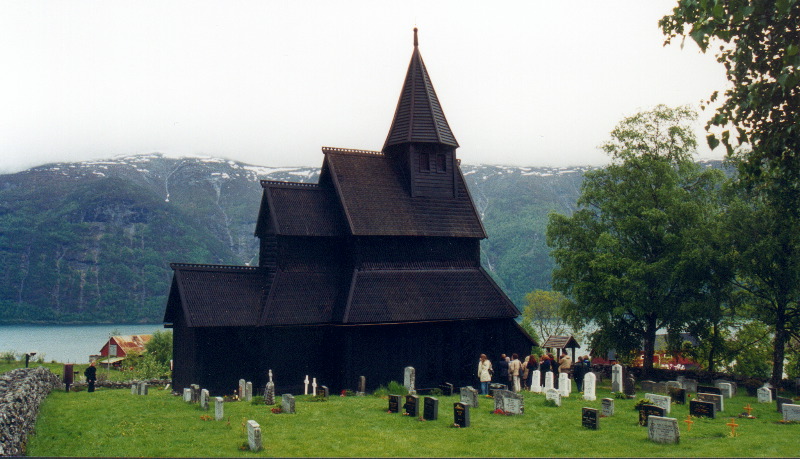- Urnes stave church
Infobox religious building
building_name = Urnes stave church
infobox_width =

image_size =
caption =
map_type =
map_size =
map_caption =
location = Ornes farm near Lustrafjorden, Luster municipality,Sogn og Fjordane county,Norway
geo = coord|61|17|53|N|7|19|21|E|type:landmark
latitude =
longitude =
religious_affiliation =Church of Norway
rite =
province =
district =
consecration_year =
status = Church
functional_status = Preserved
heritage_designation =UNESCO World Heritage Site (1979)
leadership =
website =
architecture = yes
architect = "Unknown"
architecture_type =Stave church
architecture_style = Romanesque
facade_direction =
groundbreaking =
year_completed =1132 ? (dendrochronological dating)
construction_cost =
specifications = yes
capacity =
length =
width =
width_nave =
height_max =
spire_quantity =
spire_height =
materials =Timber
nrhp =
added =
refnum =
designated =Urnes stave church (Norwegian: "Urnes stavkirke") is a
stave church at the Ornes farm, near Lustrafjorden in Luster municipality,Sogn og Fjordane county,Norway .In 1979 the Urnes stave church was listed as a
World Heritage Site byUNESCO .It is owned by
Fortidsminneforeningen (Society for the Preservation of Norwegian Ancient Monuments). Masses are occasionally held in the church.History
The church was built around 1130 or shortly thereafter, and still stands in its original location.
The church is believed to be the oldest of its kind. It provides a link between
Christian architecture and the architecture and artforms of theViking Age with typical animal-ornamentation, the so called "Urnes-style " of animal-art.Archaeological investigations have discovered the remains of one, or possibly two, churches on the site prior to the current building. The excavations uncovered holes in the ground from earth-bound posts which had belonged to an early
post church , a type of church with walls supported by short sills inserted between free-standing posts. It is not known if this church had a raised roof above the central space of the nave like the present church. The earliest possible dating of this church is the early11th century .In the 17th century the
nave of the church, which is a raised central room surrounded by an aisle, was extended southwards. Other elements were also added to the church, including abaptismal font (1640), a wooden canopy above thealtar (1665) and apulpit (1693–1695). Thealtarpiece , which depicts Christ on the cross with the Virgin Mary andJohn the Baptist , dates from 1699. Windows were added to the church in the 18th century.North portal
The portal and other details of the north wall of the present church, as well as the wall planks of the gables, are decorated in classic Urnes-style. They are probably relics from one of the earlier churches. It has been speculated that the portal may originally have been the main portal, facing west.
There have been numerous attempts to interpret the decoration (
iconography ) of the church's most remarkable part, the old portal in the northern wall. The images are generally considered to represent a snake curling upwards. At the lower end there is an animal with four feet biting the snake.A common interpretation of this scene is that it portrays the eternal fight between good and evil. The animal is widely believed to be a stylised lion. In Christian iconography the lion is a symbol of
Christ , fighting the evil symbolized by the snake, a common representation ofSatan .On the other hand, it is possible that the decoration of the earlier church featured some scenes from
Norse mythology , a likely reason for its premature reconstruction in the 12th century. In this context, the animal may be interpreted asNíðhöggr eating the roots ofYggdrasil . "The intertwined snakes and dragons represent the end of the world according to the Norse legend ofRagnarök ". [Quoted from: "A World History of Architecture", by Michael W. Fazio, Marian Moffett, Lawrence Wodehouse. McGraw-Hill Professional, 2003. ISBN 0071417516. Page 201. ]The present building
The church is built with a rectangular
nave and a narrower choir. The nave and choir both have raised central spaces. The choir was extended to the east in the 17th century, but this addition was later removed. The drawing by I. C. Dahl depicts this, as well as the deteriorated state of the church at that time. During the 20th century the church underwent a restoration, and the richly decorated wall planks were covered to stop further deterioration.A large number of medieval constructive elements remain "in situ": ground beams ("grunnstokker"), sills ("sviller"), corner posts ("hjørnestolper"), wall planks ("veggtiler") and aisle wall plates ("stavlægjer"). The construction of the raised central area with staves, strings and cross braces, and the roof itself, also date from medieval times.
From the previous church on the site remain, in addition to the portal, two wall planks in the northern wall, the corner post of the choir, the western gable of the nave and the eastern gable of the choir.
Notes
This article is based on a translation of the corresponding article from the Norwegian Wikipedia, retrieved on
14 April 2005 and updated on15 October 2005 .External links
*commonscat-inline|Urnes Stave Church
* [http://www.stavkirke.org/stavkirker/urnes.html Urnes stave church in Stavkirke.org] — in Norwegian
* [http://www.fortidsminneforeningen.no/eiendom/urnestxt.htm Urnes stave church in Fortidsminneforeningen] — in Norwegian
* [http://www.stavechurch.com Fortidsminneforeningens stave church pages] — in Norwegian (there are also English and German pages)
* [http://verhalen.reisblog.com/archives/3-Staafkerk-van-Urnes-Ornes.html Description and pictures of Urnes stave church] — in Dutch
Wikimedia Foundation. 2010.
